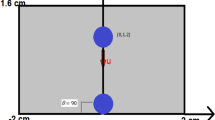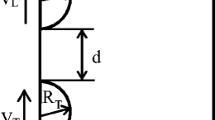Abstract
In this chapter, we present three-dimensional numerical calculations of the collision and coalescence of multiple water drops of equal size in a vacuum environment, using a Lagrangian mesh-free scheme based on the Smoothed Particle Hydrodynamics (SPH) formalism. The water drops are modelled using a general Mie-Grüneisen equation of state. Attention is focused for collision velocities from low to moderate so that shattering separation is excluded. Depending on the collision velocity three different possible outcomes are predicted by the calculations: permanent coalescence, coalescence accompanied by fragmentation into a few satellite droplets, and flocculation of the drops with no coalescence.
Access provided by Autonomous University of Puebla. Download chapter PDF
Similar content being viewed by others
Keywords
- Smooth Particle Hydrodynamic
- Liquid Drop
- Smooth Particle Hydrodynamic
- Smoothing Function
- Smooth Particle Hydrodynamic Method
These keywords were added by machine and not by the authors. This process is experimental and the keywords may be updated as the learning algorithm improves.
1 Introduction
Many studies have been proposed for the numerical simulation of the coalescence and break up of liquid drops (Foote 1974; Nobari et al. 1996; Eggers et al. 1999; Cristini et al. 2001; Mashayek et al. 2003; Narsimhan 2004; Roisman 2004; Pan and Suga 2005; Meleán and Sigalotti 2005; Jia et al. 2006; Decent et al. 2006; Azizi and Al Taweel 2010; Acevedo-Malavé and García-Sucre 2011a, b, c, 2012). In these studies, different numerical methods have been proposed to simulate the dynamics of liquid drops by numerical integration of the Navier-Stokes equations. While most of them have focused on describing the dynamics of drop coalescence, only a few has studied the details of the liquid bridge that arises when two drops collide. The effects of the Reynolds number, the impact velocity, the drop size ratio, and the internal circulation on coalescence have been investigated and different regimes for droplets’ collisions have been simulated. For binary collisions, these calculations have predicted four different regimes, namely bouncing, coalescence, reflexive separation, and stretching separation. These numerical simulations indicate that collisions leading to rebound between colliding drops can be described macroscopically.
The mechanism of formation of satellite drops at moderate collision velocities was also studied, confirming that the principal cause of the formation of satellite drops is the “end pinching”, while the capillary wave instabilities are the dominant features in cases where a large value of the parameter impact is employed. Whereas almost all of these previous calculations were confined either to 2D or axi-symmetry, Acevedo-Malavé and García-Sucre applied the Smoothed Particle Hydrodynamics (SPH) method to model for the first time the hydrodynamic coalescence collision of two liquid drops in 3D. As a result of the collision process, the formation of a circular flat film is first observed. In these references three possible outcomes for the collision between the drops were found, which correspond to: permanent coalescence, fragmentation, and flocculation of drops. If the collision velocity is greater than the range of values for permanent coalescence, a fragmentation phenomenon is observed, and if the collision velocity is too low the surface tension forces are dominant and the drops interact only through their deformed surfaces. A detailed description of the SPH equations and the approach used in this chapter can be found in these previous references. In this work, the same SPH method is applied to simulate the 3D hydrodynamic collision of multiple liquid drops and the formation of drop clusters in a vacuum environment.
2 The Smoothed Particle Hydrodynamics Formalism
Smoothed Particle Hydrodynamics is a mesh-free, Lagrangian method for solving the equations of fluid dynamics (Monaghan 1985). In the SPH model, the fluid is represented by a discrete set of \(N\) particles. The position of particle \(i\) is denoted by the position vector \(\mathbf{r}_{i}\), with \(i=1,\ldots , N\). In essence, the scheme is based on the idea that the smoothed representation \(A_{s}(r)\) of a continuous function \(A(r)\) can be represented by the convolution integral over the product of a smoothing function (or interpolating kernel) and the function itself.
The smoothing function \(W\) must satisfy the normalization condition
where the integration is performed over all space and \(h\) is the smoothing length that determines the spatial resolution. In the limit when h tends to zero, the smoothing function \(W\) becomes a Dirac delta function and so the smoothed representation of \(A_{s}(r)\), as stated above, tends to the exact function \(A(r)\). In SPH the integrals over all space are replaced to second-order accuracy by summations over all neighbouring particles.
In this way, in SPH the mass density \(\rho _{i}\) at the location of particle \(i\) is given by the summation
where \(m_{j}\) is the mass of the \(j\)th particle that is a neighbour of particle \(i\).
The position \(\mathbf{r}_{i}\) and velocity \(\mathbf{v}_{i}\) of particle \(i\) are given by the well-known SPH discretization equations
where \(\sigma \) is the total stress tensor.
A cubic B-spline kernel is used as the smoothing function (Monaghan 1985). We consider water drops and use a general Mie-Grüneisen equation of state with different analytic forms for the states of compression (\(\rho /\rho _{0}-1)>0\) and tension (\(\rho /\rho _{0}-1)<0\) (Acevedo-Malavé and García-Sucre 2011a).
3 Coalescence Collision of Multiple Drops and the Formation of Drop Clustering
Here we describe the results of a set of collision models in which five liquid drops are made to coalesce permanently for different choices of the value of the collision velocity. In a first model configuration, four drops with a diameter of 30 \(\upmu \)m and 5512 particles each are made to collide with a central one with a collision velocity of 15.0 mm/ms directed towards the centre of mass of the system.
We may see in Fig. 1 that at \({t}=3.08\times 10^{-4 }\) ms a flat circular section forms, which increases its diameter as the coalescence dynamics progresses. At \({ t}=4.77\times 10^{-4 }\) ms the coalescence process begins, and the fluid of the four converging drops starts to penetrate in the drop placed at the centre of the system. At \({ t}=7.38\times 10^{-4 }\) ms a little wave front arises in the (x = 0, y = 0)-plane, which then disappears at \({ t}=8.46\times 10^{-4 }\) ms. As a result of coalescence, a bigger drop forms, which tends to a spherical shape as the evolution proceeds (\({ t}=1.10\times 10^{-3 }\) ms). Figure 2 shows the velocity vector field inside the drops as well as in their regions of contact at \({ t}=3.08\times 10^{-4 }\) ms. It is important to note that inside the drops, the fluid tends to a velocity value close to the initial velocity of 15.00 mm/ms, while in the areas of contact of the drops the fluid velocity increases to about 17.00 mm/ms. This difference in the velocity is due to the non-uniform pressure field that sets in inside the drops when the coalescence process has begun.
In Fig. 3, we show the evolution when five drops of diameter 30 \(\upmu \)m and 5512 particles each collide with a higher velocity \(\mathrm{V}_{x}=30.0\) mm/ms. As before the configuration is such that four drops are made to collide with a central one. At the beginning of the calculation at \({ t}=1.51\times 10^{-4 }\) ms, a flat circular section between the drops forms again. This section disappears at \({ t}=2.42\times 10^{-4 }\) ms when coalescence begins. At \({ t}=4.20\times 10^{-4 }\) ms four wave fronts arise from the resulting mass of fluid and these wave fronts start to form little satellite droplets. Figure 4 shows the velocity vector field before fragmentation of the drops has taken place. Note that the fluid velocity at the centre of the drops is around the initial collision value of 30.00 mm/ms, while the fluid that is spread to the edges is accelerated reaching speeds of about 49.00 mm/ms.
In Fig. 5, we model the flocculation process for five drops having 30 \(\upmu \)m of diameter and 5512 particles each, and a much lower collision velocity \(\mathrm{V}_{x}=0.2\) mm/ms. As in the previous cases, the velocities of the four approaching drops are directed towards the central drop. At \({ t}=1.13\times 10^{-3}\) ms, a flat circular section forms among the five droplets. As the simulation continues, the drops do not coalesce but rather form a cluster, remaining in contact only through their deformed (flat) surfaces.
4 Conclusions
The SPH method was used to simulate the hydrodynamic collision of multiple drops and the formation of clusters of liquid drops in a vacuum environment in three-space dimensions. The characteristic behaviour of the collision process when multiple drops are involved was reproduced. A circular section between the drops appears as a consequence of the surface tension forces acting on the drop surfaces at contact. Depending on the collision velocity, three possible outcomes are predicted after the collision process: coalescence, coalescence accompanied by fragmentation into satellite droplets, and clustering of drops with no coalescence. The non-uniform pressure difference inside the drops tends to accelerate the fluid close to the zones of contact between them. This work represents a step ahead towards the modelling of drop coalescence in emulsion systems. In a future work, we plan to study the collapse of the interfacial film in emulsion systems during drop coalescence. For this purpose, a hybrid approach that combines SPH with molecular dynamics must be implemented in order to solve the interfacial film just before the collapse of the film occurs (100Å of thickness). In a future work this aspect of the problem will be explored.
References
Acevedo-Malavé A, García-Sucre M (2011a) 3D coalescence collision of liquid drops using smoothed particle hydrodynamics, vol 5. INTECH Publishers, pp 85–106.
Acevedo-Malavé A, García-Sucre M (2011b) Coalescence collision of liquid drops. I. Off-center collisions of equal-size drops. AIP Adv 1:1–17
Acevedo-Malavé A, García-Sucre M (2011c) Coalescence collision of liquid drops. II. Off-center collisions of unequal-size drops. AIP Adv 1:1–12
Acevedo-Malavé A, García-Sucre M (2012) Head-on binary collisions of unequal size liquid drops with smoothed particle hydrodynamics. Transworld Res Netw 9:245–266
Azizi F, Al Taweel AM (2010) Algorithm for the accurate numerical solution of PBE for drop breakup and coalescence under high shear rates. Chem Eng Sci 65:6112–6127
Cristini V, Bawzdziewicz J, Loewenberg M (2001) An adaptive mesh algorithm for evolving surfaces: simulations of drop breakup and coalescence. J Comput Phys 168:445–463
Decent SP, Sharpe G, Shaw AJ, Suckling PM (2006) The formation of a liquid bridge during the coalescence of drops. Int J Multi-phase Flow 32:717–738
Eggers J, Lister JR, Stone HA (1999) Coalescence of liquid drops. J Fluid Mech 401:293–310
Foote GB (1974) The water drop rebound problem: dynamics of collision. J Atmos Sci 32:390–401
Jia X, McLaughlin JB, Kontomaris K (2006) Lattice Boltzmann simulations of drop coalescence and chemical mixing. Phys. A 362:62–67
Mashayek F, Ashgriz N, Minkowycz WJ, Shotorban B (2003) Coalescence collision of liquid drops. Int J Heat Mass Transf 46:77–89
Meleán Y, Di Sigalotti LG (2005) Coalescence of colliding van der Waals liquid drops. Int J Heat Mass Transf 48:4041–4061
Monaghan JJ (1985) Extrapolating B splines for interpolation. J Comput Phys 60:253–262
Narsimhan G (2004) Model for drop coalescence in a locally isotropic turbulent flow field. J Coll Interf Sci 272:197–209
Nobari MR, Jan YJ, Tryggvason G (1996) Head-on collision of drops–a numerical investigation. Phys Fluids 8:29–42
Pan Y, Suga K (2005) Numerical simulation of binary liquid droplet collision. Phys Fluids 17:1–14
Roisman L (2004) Dynamics of inertia dominated binary drops collisions. Phys Fluids 16:3438–3449
Author information
Authors and Affiliations
Corresponding author
Editor information
Editors and Affiliations
Rights and permissions
Copyright information
© 2014 Springer International Publishing Switzerland
About this chapter
Cite this chapter
Acevedo-Malavé, A. (2014). Hydrodynamics of Multiple Coalescence Collisions of Liquid Drops: From the Modelling of the Coalescence Phenomenon to Flocculation of Drops in 3D Using the SPH Formalism. In: Sigalotti, L., Klapp, J., Sira, E. (eds) Computational and Experimental Fluid Mechanics with Applications to Physics, Engineering and the Environment. Environmental Science and Engineering(). Springer, Cham. https://doi.org/10.1007/978-3-319-00191-3_18
Download citation
DOI: https://doi.org/10.1007/978-3-319-00191-3_18
Published:
Publisher Name: Springer, Cham
Print ISBN: 978-3-319-00190-6
Online ISBN: 978-3-319-00191-3
eBook Packages: Earth and Environmental ScienceEarth and Environmental Science (R0)









